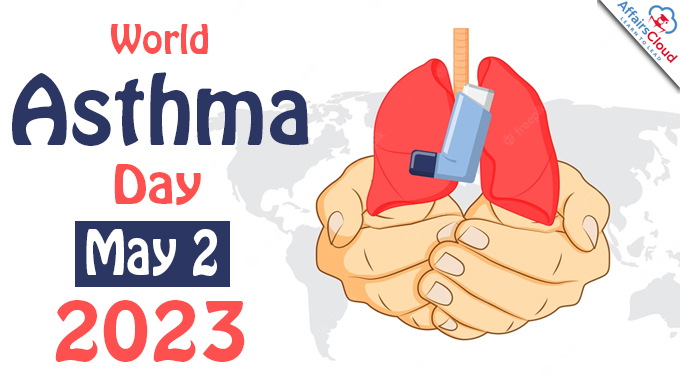 World Asthma Day (WAD) is annually observed across the world on the first Tuesday of May month to create awareness about asthma, a condition in which a person’s airways become inflamed, narrow and swell and produce extra mucus, which makes it difficult to breathe.
World Asthma Day (WAD) is annually observed across the world on the first Tuesday of May month to create awareness about asthma, a condition in which a person’s airways become inflamed, narrow and swell and produce extra mucus, which makes it difficult to breathe.
World Asthma Day 2023 is observed on 2nd May 2023.
- WAD 2022 was observed on 3rd May 2022.
- WAD 2024 will be observed on 7th May 2024.
The theme of World Asthma Day (WAD) 2023 is “Asthma care for All”
- The goal of WAD 2023 theme is to encourage all resource rich countries to create and execute extensive asthma management programmes globally.
World Asthma Day is annually organised by the GINA (Global Initiative for Asthma).
- Each year GINA chooses a theme and coordinates preparation and distribution of World Asthma Day materials and resources.
Note:
In 2023, GINA celebrates 30 years of working to improve the lives of people with Asthma by translating medical evidence into better asthma care worldwide.
Background:
The first World Asthma Day was observed by the GINA in 1998 and it was celebrated in more than 35 countries in conjunction with the first World Asthma Meeting held in Barcelona, Spain.
Why May?
The month May is chosen because it coincides with the spring and the fall season, the symptoms of asthma worsen during the time of the year.
What is Asthma?
i. Asthma is a condition of chronic (long-term) disease that obstructs the respiratory system, causing difficulty breathing.
ii. As there is no cure for this condition, but treatment to control the symptoms is available and effective measures can reduce the chance of making the disease dangerous.
iii. Clean environments, regular breathing of fresh and clean air, avoiding taking drugs and quitting smoking are some of the beneficial ways to keep us away from the disease.
Causes of Asthma:
i. The causes of Asthma may be different from person to person. Still it happens when the immune system strongly reacts to a substance in the lungs.
ii. Mostly it is caused by swollen (inflamed) and sensitive airways that become narrow and clogged with sticky mucus in response to certain triggers like allergies from dust, animal fur or feathers and infections like cold and flu, smoke, pollution and so on.
iii. Genetics, pollution and modern hygiene standards have been suggested as causes, but currently there is not enough evidence to know if any of these do cause asthma.
Symptoms:
The most common symptoms of asthma are: Wheezing, Shortness of breath, chest tightness and coughing.
- Children and adults who are overweight or obese are at a greater risk of asthma.
Key Points:
i. According to WHO the diagnosis and treatment of Asthma are considered to be a challenge in low- and lower-middle-income countries.
ii. Both the United Nations (UN) 2030 Agenda for Sustainable Development and the WHO’s Global Action Plan for the Prevention and Control of Non-Communicable Diseases recognise asthma as a priority and implement various strategies to increase asthma diagnosis, prevention and treatment.
About Global Initiative for Asthma (GINA):
GINA was launched in 1993 in collaboration with the National Heart, Lung, and Blood Institute (NHBL) and National Institutes of Health in the United States of America (USA), and the World Health Organisation (WHO).
MD, Chairperson– Arzu Yorgancioglu (Türkiye)Headquarters– Wisconsin, United States of America (USA)




